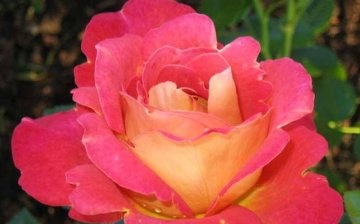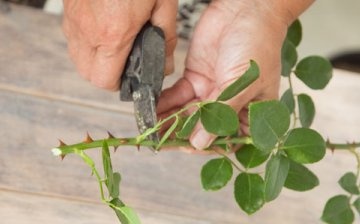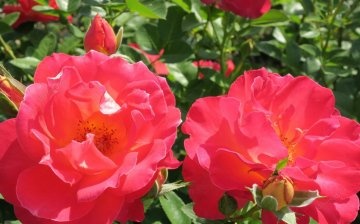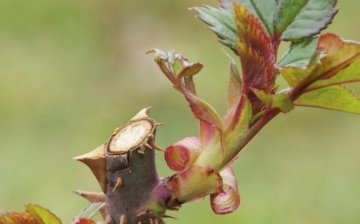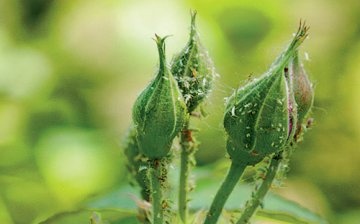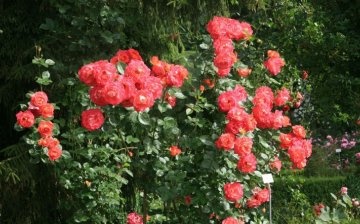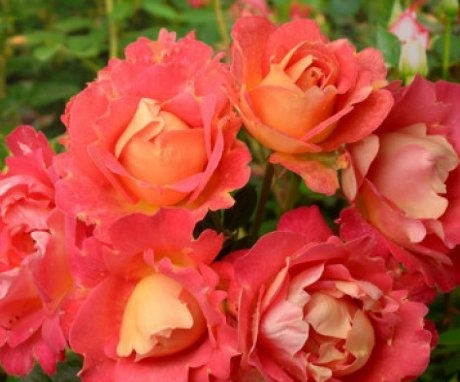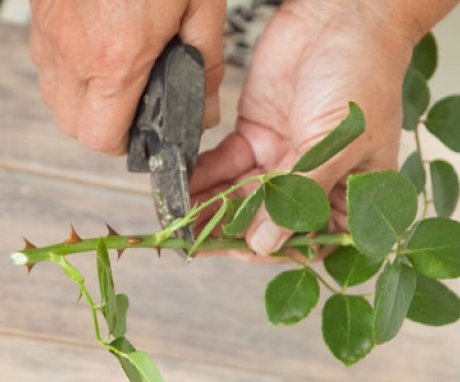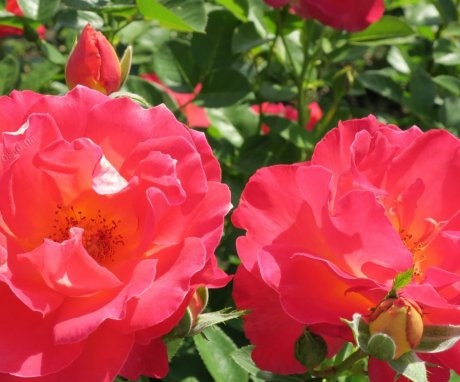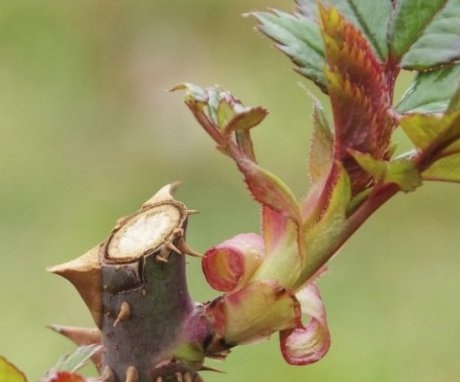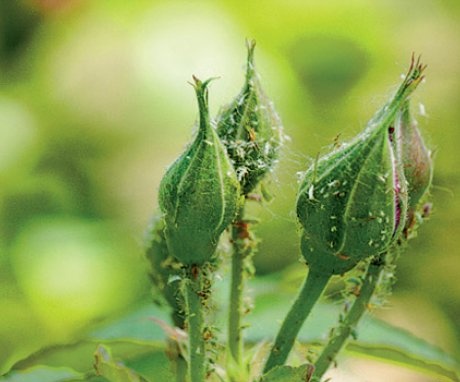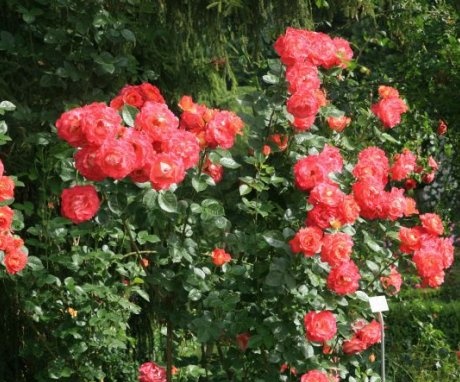Rose Decor Harlequin: cultivation and application in garden design
Any gardener who grows his own well-kept garden wants to plant and grow on his own an interesting Harlequin Decor rose. Its features are amazing, so few people will not be mesmerized by its original flowering. But before planting, you should study all the information about her care, reproduction, spring pruning and preparation for wintering.
Content:
- Description and benefits of the variety
- Reproduction and planting
- How to properly care for this rose
- Pruning and preparing for winter
- Diseases and pests
- Application on site
Description and benefits of the variety
Rose Harlequin was bred not so long ago - in 1986. It is distinguished by an interesting color scheme - the inflorescences are presented in a pink-orange tone, the outer side of the petal invariably remains yellow-pinkish. When fully opened, the petals have a pink-crimson hue with a yellow core. The structure of the rose is terry. She attracts with her extraordinary appearance and the ability to change colors. That is why she acquired the name - Harlequin.
The rose bush not only differs in color, it tends to reach up to 170 cm in height.
If not properly pruned, bright color-changing inflorescences will only show off in front of the birds. Therefore, it is recommended that, in order to admire the interesting shade and structure, you need to do a strong formative pruning, and restrain the growth of the shrub. In width, the rose garden almost always grows up to 1 m.
rose flower has a fragrant scent that fills the most remote corners of the garden, so the path to it can be determined by the scent. Flowering takes place for a long period. At this moment, the bush is covered with a large number of inflorescences of various colors and sizes. The leaves of the plant are glossy, leathery, with clearly defined veins. Its specific feature is rapid growth and development of new shoots. If you do not stop the growth of the bush, it can completely fill a small area.
Reproduction and planting
The easiest way to propagate roses is cuttings... Only after rooting the cuttings can an original plant with maternal growth and flowering qualities be obtained. In most cases, all growers use this method of propagation of the Harlequin Decor rose, because it is impossible to get it by another method.
A cut seedling is formed at the moment when the bud is formed until it completely blooms. An earlier cut leads to the fact that the stem will not be ripe and then the remaining nutrients will not be used for formation. root system, and to bring the stem to the required state. Such a process will deplete the cutting and will not give normal results during the growing process.
The main thing is not to pick up a stalk with a stiff inside.
Should be purchased or prepared with green, ripe bases only. The best option for planting would be a medium-sized stalk, no more than 1 cm in diameter. The stem is trimmed at an acute angle, 1.5 cm below the last point. From above, it trims 1 cm above the last point. In total, no more than 3-4 internodes should be left.It is necessary to completely clean the lower cut, while removing both the thorns and the sheet plate. Cut the remaining leaves from above by 1/3 of the total mass.
It is recommended to keep the upper open cut in potassium permanganate for 10-15 minutes and dip the top in melted wax for a few seconds. This is necessary so that pathogenic bacteria and pathogenic pests do not join the plant. Before rooting, the cutting should be kept in a rooting stimulator solution. The exposure time is 24 hours. For planting, you should use a nutritious soil substrate. For this purpose, it is recommended to combine 1 part of river sand and leaf land, add 0.5 tbsp. wood ash, 2 parts of humus and 4 parts of sod soil.
Pre-dig a depression in the ground up to 15 cm in size, pour the prepared mixture there and plant the cutting, after sprinkling with the remaining soil mixture. The seedling is stuck into the ground 2 cm at an angle of 45 degrees. After landing, you should spill a weak solution of potassium permanganate and the cutting and the ground around it, and then cover with a plastic bottle. The latter is necessary to reproduce greenhouse conditions for faster and more efficient production of high-quality seedlings.
How to properly care for this rose
After planting, the optimum air temperature of +20 .. + 25 C should be maintained, therefore, in most cases, reproduction should be carried out in spring. Watering and airing the seedling is mandatory.
Shrub Care Tips:
- In order for the plant to grow qualitatively and please with its abundant growth and color, it is necessary to plant seedlings in light, fertile soils. Soils of heavy consistency with a high clay content, while with a close occurrence of groundwater, is categorically unsuitable.
- Due to the fact that the root system of the Harlequin Decor rose is close to the surface, the summer heat constantly dries the soil. There is a possibility, with prolonged drought and lack of normal watering, the death of the bush. Therefore, the rose requires irrigation periodically as needed to dry out the soil under the bush.
- It is periodically recommended to loosen the soil, but you should overdo it. Strong deepening can damage the root system of the seedling, which will provoke either a long-term illness or the death of the entire bush.
- In order not to carry out loosening often, you can use mulch. It not only prevents the rapid evaporation of moisture from the soil, but also prevents water from stagnating and growing ubiquitous weeds.
- The main point that must be carried out is the dressing of the Harlequin Decor rose. Thanks to the timely application of fertilizers, the plant has time to prepare for winter and endure a strong decrease in temperature.
Pruning and preparing for winter
Pruning for roses is necessary in order for the shrub to bloom further, replacing loose buds and cuttings.
Several scraps stand out - sanitary, rejuvenating and shaping:
- Sanitation should be carried out at any time of the year. It is necessary to remove broken branches damaged by winds or heavy snow. Also, the plant can be attacked by diseases or pests. Branches affected by such ailment need to be eliminated.
- Rejuvenating pruning is recommended either in the fall before frost or in early spring. It involves the removal of old, weak and faded shoots. Even young growth is removed, which only interferes with the development of large powerful shoots.
- Formative pruning for a rose The Harlequin decor should be done in the spring so that the plant does not stretch towards the sun, but blooms at eye level. At the same time, they not only shorten the stretching vines, but also eliminate the shoots that grow deep into the shrub, thickening the overall structure.
Spring pruning should be carried out at the end of March - beginning of April, when the last frosts pass, the snow will come off the ground and the temperature outside will rise to +7 .. + 10 C.In addition to shortening the long branches, it is very important for a rose to have its shelter for the winter. Shelter should be started in November or early December.
It is forbidden to use film for shelter. In this case, the rose will begin to rot, and if the fungal disease does not join, then the upper shoots will begin to rot. Burlap is ideal for shelter. It will not allow the winds to break the bushes, and in case of frost, protection from freezing. At the same time, during the warming up of the sun, it will not allow to provoke early sap flow. In addition, the base should be covered with additional earth mound or crushed peat. Top should be covered with spruce branches.
Diseases and pests
Rose Decor Harlequin has sufficient resistance to various diseases. It can only be exposed to pathogenic bacteria under unfavorable conditions. But a number of diseases and pests are distinguished that can harm the original shrub:
- Aphid - feeds on plant sap, lives on the tips of the stems, mainly on the buds, is localized on the underside of the leaf plate. Often occupies rose buds. It is recommended to cut off the populated areas of the bush to eliminate it. Spraying with an infusion of wormwood or by exposing yourself to a self-infused mash on nettles should be carried out. If folk remedies do not help, you should seek help. chemical insecticides.
- Cicadas are the smallest pests that live on the underside of the leaf. A characteristic sign of their appearance is the fixation of white spots on the outside of the leaves. To eliminate insects, it should be treated with a solution of laundry soap.
- Spider mite - yellow spots appear on the leaves, then they turn gray and the leaf dies. If the mite rapidly increases in number, white cobweb threads become visible on the plant. To combat, damaged leaves and branches should be removed, if the bush is completely affected, irrigate with a solution of field horsetail or tobacco infusion.
- Gray rot - occurs with high humidity. In this case, it is recommended to feed with manganese and treat with 1% Bordeaux liquid.
- Rust - the appearance of spots of yellow, brown color. On the underside of the leaf plate, black plaque with villi of formed spores is visible. Control measures are carried out when exposed bordeaux liquid (1%) and soap-ash solution.
- Powdery mildew - prolonged wet and damp weather. At this moment, a white bloom appears on the foliage, which is easily removed by touching or under the influence of a jet of water. The shrub should be planted in an open area, more often carry out thinning pruning and spray periodically with Bordeaux liquid.
Thus, in order for the plant to feel normal and not suffer from the invasion of parasites or pathogenic bacteria, the general condition of the plant should be monitored. At the first sign of exposure to folk methods or chemical insecticides.
Application on site
Rose Decor Harlequin is recommended for growing as hedges, marked by high growth, and also as an ornamental plant in multi-level flower beds or alleys.
If the plant is planted on a personal plot, then it can be distinguished and made the highlight of the entire garden.
In addition, she can participate in flower bed compositions, where the queen of the garden will be the center of attention. Shrubs and plants are planted nearby, which will set off the unique original color.
Thus, the Harlequin Decor rose, if grown incorrectly, stretches significantly in growth, which adversely affects the general appearance and condition of the shrub. To enjoy the beauty and abundance of flowering, the plant should be subjected to formative pruning.In addition, high-quality pruning affects the impossibility of colonizing pests and pathogenic bacteria that can develop inside the shrub.
More information can be found in the video:



